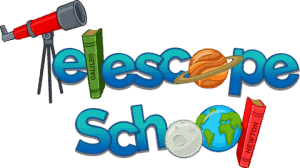As I age, my back was telling me about this concept of weight of different telescopes and related sizes. This is my conclusion of data, I hope you benefit from knowing How Much Telescopes Weigh
The average weight per millimeter of telescope aperture is: 0.199 lbs (0.090 kg). So, on average, a 100mm telescope weighs 19.9lbs (9.0kg). The weight typically includes the factory telescope mount if provided.
| Description | Average Aperture (mm) | Average Weight | Weight/mm of Aperture | Average F/Ratio | Average Price |
|---|---|---|---|---|---|
| Refractor | 76.67 mm | 13.91 lb (6.3kg) | 0.163 lb (.073kg) | 7.92 | $185 |
| Reflector | 124.97 mm | 20.74 lb (9.41kg) | 0.166 lb (.075kg) | 6.38 | $160 |
| Cassegrain | 163.16 mm | 41.89 lb (19kg) | 0.230 lb (.105kg) | 11.41 | $950 |
| Dobsonian | 215.93 mm | 54.11 lb (24.54kg) | 0.241 lb (.109kg) | 5.89 | $490 |
| APO Refractor | 100.00 mm | 18.64 lb (8.45kg) | 0.193 lb (.088kg) | 7.40 | $1,690 |
| Overall Avg | 136.14 mm | 29.86 lb (13.54kg) | 0.199 lb (.090kg) | 7.80 | $475 |
If you are buying something outside the average…in other words, you are a rebel. You want a telescope, perhaps a little different; let’s get “weigh” deeper on this subject below! (Promise no more lousy humor)
Telescope Weight Comparative Table & Chart
Refractor
Let’s start with the most common style. You can see compared to reflector style that the weight is higher per aperture size. This is mainly a result of the extra glass or lenses involved in focusing the light.
Learn more about a refractor telescope here.
Refractor Table
| Manufacturer | Model | Aperture (mm) | Weight in lbs | Weight (lbs) per mm | kg's | F/ratio |
|---|---|---|---|---|---|---|
| Celestron | Travel Scope 50 | 50 | 2.70 | 0.0540 | 1.22 | 7.2 |
| Meade | 209001 | 50 | 2.87 | 0.0574 | 1.30 | 12.0 |
| Gysker | 60350 | 60 | 8.60 | 0.1433 | 3.90 | 11.6 |
| Celestron | Travel Scope 70 | 70 | 4.20 | 0.0600 | 1.90 | 5.7 |
| Gysker | AZ70400 | 70 | 4.80 | 0.0685 | 2.18 | 5.7 |
| Celestron | Power Seeker 70EQ | 70 | 13.90 | 0.1986 | 6.30 | 10.0 |
| Celestron | Travel Scope 80 | 80 | 4.50 | 0.0563 | 2.04 | 5.0 |
| Gysker | 80mm AZ80400 | 80 | 15.50 | 0.1938 | 7.03 | 5.0 |
| Gysker | 600X90 AZ | 90 | 17.00 | 0.1889 | 7.71 | 6.7 |
| Celestron | AstroMaster 90EQ | 90 | 27.00 | 0.3000 | 12.24 | 11.0 |
| Orion | 9024 AstroView90 | 90 | 29.50 | 0.3278 | 13.38 | 10.1 |
| Orion | 9005 AstroView 120ST | 120 | 36.30 | 0.3025 | 16.46 | 5.0 |
The chart gives an excellent visual reference to size and weight along with the f/ratio. For example, the Meade and Celestron 127 EQ, the Meade is 6.5lb (3kg) heavier…
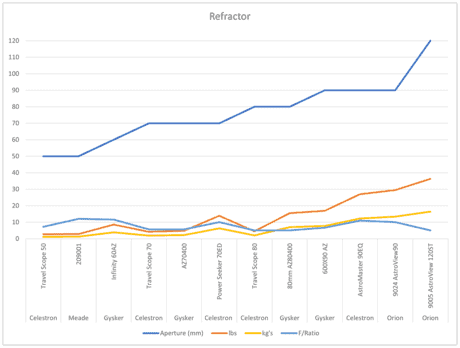
Reflector
So, the reflector style scope, This telescope is lighter because there is less glass involved. The reflector telescope, also called a “Newtonian” after Isaac Newton, uses one big mirror that directs light at another second mirror.
Some claim the downfall of this design is you need bigger apertures to receive the same amount of light. Learn more about reflector scopes here.
Reflector Table
| Manufacturer | Model | Aperure (mm) | Weight lbs | Weight (lbs) per mm | Weight Kg | F/ratio |
|---|---|---|---|---|---|---|
| Orion | Sky Scanner 100 | 100 | 6.2 | 0.0620 | 2.81 | 4.0 |
| Celestron | 114LCM | 114 | 13.2 | 0.1158 | 5.97 | 8.8 |
| Celestron | AstroMaster 114EQ | 114 | 17.0 | 0.1491 | 7.71 | 8.7 |
| Celestron | Power Seeker 114EQ | 114 | 18.9 | 0.1658 | 8.57 | 8.0 |
| Orion | 10015 Star Blast | 114.3 | 13.0 | 0.1137 | 5.90 | 4.0 |
| Orion | Orion Starblast ii 4.5 | 114.3 | 20.7 | 0.1811 | 9.39 | 3.9 |
| Celestron | PowerSeeker 127EQ | 127 | 21.4 | 0.1683 | 9.70 | 8.0 |
| Meade | 216005 Polaris 127EQ | 127 | 27.9 | 0.2197 | 12.65 | 7.9 |
| Celestron | AstroMaster 130EQ | 130 | 17.0 | 0.1308 | 7.71 | 8.7 |
| Celestron | NexStar 130SLT | 130 | 18.0 | 0.1385 | 8.16 | 5.0 |
| Orion | SpaceProbe 130ST | 130 | 24.2 | 0.1862 | 10.98 | 5.0 |
| Meade | 216006 Polaris 130EQ | 130 | 26.8 | 0.2062 | 12.15 | 5.0 |
| Celestron | Advanced VX Series 6" | 150 | 39.5 | .2633 | 17.90 | 5.0 |
| Orion | 10016 StarBlast 6 | 150 | 23.6 | 0.1573 | 10.70 | 5.0 |
You can see quickly by looking at this chart how the size aperture has a fairly large gap over the other specs like weight and f/ratio. It would have been cool to add prices too, but they change too much overtime.
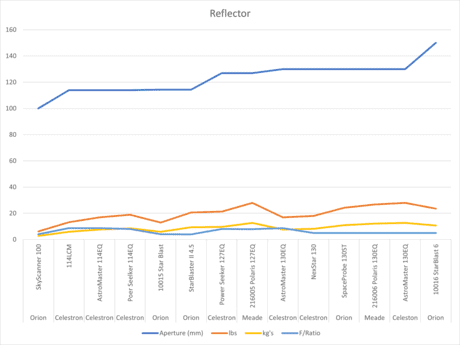
Cassegrain
In simplistic terms, a cassegrain, also known as a compound telescope, is a combination of refractor and reflector styles. To learn more about a cassegrain, click here.
I personally look at it as a compound bow. Light enters (like a refractor) and is directed to a mirror that reflects it back to a 2nd mirror (like a reflector), which then sends the light through the center hole of the mirror toward your eyepiece.
How is it like a compound bow? Because one lens or mirror compounds on the next mirror. (replace mirror with the word pully, it may help see the weird way I think?)
Cassegrain Table
| Manufacturer | Model | Aperure (mm) | Weight lbs | Weight (lbs) per mm | Weight Kg | F/ratio |
|---|---|---|---|---|---|---|
| Orion | 10022 StarMax 90 | 90 | 6.5 | 0.0722 | 2.95 | 13.9 |
| Meade | 205004 ETX90 | 90 | 18.9 | 0.2100 | 8.57 | 13.8 |
| Meade | 205005 ETX125 | 125 | 25.7 | 0.2056 | 11.66 | 15.0 |
| Celestron | Nexstar 5SE | 125 | 27.6 | 0.2208 | 12.52 | 10.0 |
| Celestron | Nexstar 6SE | 150 | 30.0 | 0.2000 | 13.61 | 10.0 |
| Meade | 228004 LX65 | 203 | 39.5 | 0.1946 | 17.91 | 10.0 |
| Celestron | Nexstar 8SE | 203.2 | 33.0 | 0.1624 | 14.97 | 10.0 |
| Celestron | Advance VX8 | 203.2 | 80.0 | 0.3937 | 36.28 | 10.0 |
| Celestron | CGX1100 HD | 279 | 115.8 | 0.4151 | 52.52 | 10.0 |
If you notice on the graph that the F/ratio is hard to read, but you can make out that the F/ratio is 10 or higher on compound scopes. The highest in the chart is the Meade ETX125 at 15 F/ratio.
This higher F ratio allows for greater magnification abilities, and therefore great for planet viewing.
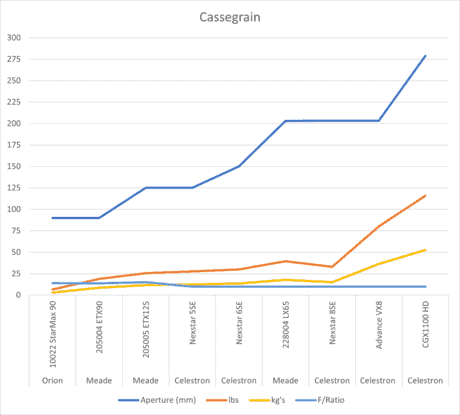
Dobsonian
Affectionately called a light bucket by adoring Dob owners, these guys are large reflector style telescopes that have bases instead of mounts. The larger aperture can often be a truss and tube design. Learn More about Dobsonian telescopes here.
Astronomers often make unique platforms known as “wedges” that can be motorized with computer controls or just a motor for tracking celestial objects. These are available from manufacturers as well. Dob’s are often the style telescope that are homemade too.
Dobsonian Table
| Manufacturer | Model | Aperture (mm) | Weight lbs | Weight (lbs) per mm | Weight Kg | F/ratio |
|---|---|---|---|---|---|---|
| Orion | SkyQuest XT6 | 152.4 | 20.1 | 0.1319 | 9.12 | 8.0 |
| Orion | XT8 | 203.2 | 41.0 | 0.2018 | 18.59 | 5.9 |
| Orion | XT8i | 203.2 | 41.6 | 0.2047 | 18.87 | 5.9 |
| SkyWatcher | S11610 | 203.2 | 45.0 | 0.2215 | 20.41 | 5.9 |
| Zhumell | Z8 | 203.2 | 54.0 | 0.2657 | 24.49 | 5.9 |
| SkyWatcher | S11700 | 203.2 | 60.0 | 0.2953 | 27.21 | 5.9 |
| SkyWatcher | 11810 GoTo | 254 | 72.0 | 0.2835 | 32.65 | 4.7 |
| SkyWatcher | S11820 | 305 | 99.2 | 0.3252 | 44.99 | 4.9 |
It is hard to tell what the F/ratio is on the chart below, but it starts at 8 f/ratio for the 6” SkyQuest. And ends with 5 f/ratio for the Skywatchers. Dob’s are often used for a wide field of view, and a low F/ratio is desired.
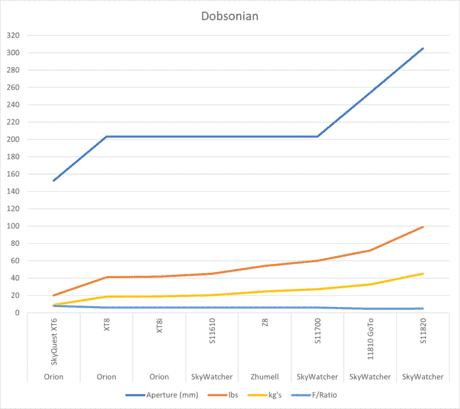
APO Refractor
What is the difference between an APO refractor and a standard refractor? The first thing noticeable is the price. The same size aperture in an APO runs about 10X more than our normal refractor scope. Yep, a nice $200 refractor would be about $2000 (without the mount, by the way).
Why is that? Well, the quality of lenses and the amount of lenses used in manufacturing is why. They use multiple lenses to practically remove aberration and distortions. Many astrophotographers desire APO’s.
APO Refractor Table
| Manufacturer | Model | Aperure (mm) | Weight lbs | Weight (lbs) per mm | Weight Kg | F/ratio |
|---|---|---|---|---|---|---|
| Vixen | 2617 ED80S | 80 | 13.0 | 0.1625 | 5.90 | 7.5 |
| SkyWatcher | ProEd Doublet APO | 80 | 22.0 | 0.2750 | 9.98 | 7.5 |
| SkyWatcher | ProEd 100 Doublet | 100 | 29.0 | 0.2900 | 13.15 | 9.0 |
| Orion | 10031 EON 110 ED | 110 | 11.5 | 0.1045 | 5.22 | 6.0 |
| Meade | 6000 130 APO Trplet | 130 | 17.7 | 0.1362 | 8.03 | 7.0 |
You will notice the weight of an APO is heavier than a typical refractor on the graph too. It is evidence of the extra glass weight involved.
Also, all the APO’s do not come with mounts, so the mount’s weight would be extra poundage.
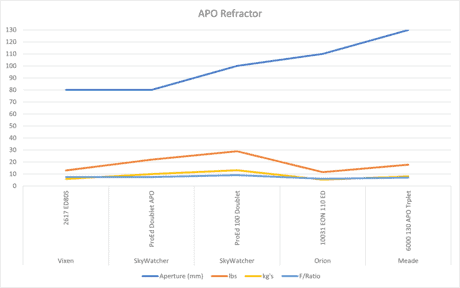
Not in the Table? How To Calculate Your Scope’s Weight
OK, if you own it, you most likely know, but I am talking about a telescope you intend on purchasing, and it is not in the tables above.
This is where you would take the average of the style scope you’re intending and multiply it by your aperture to get a nice ballpark estimate.
(Average Wt per mm) X (Aperture size in mm)
How The Weight was Calculated for The Table
I took the top-selling sizes in their class and found the manufacturer’s weights, less packaging. Almost all mounts that came with the scope were included in the weight calculations.
Further, tabletop-style scopes were definitely inclusive as the unit’s complete weight since the mount is part of the telescope.
Then, we found the average of each style telescope and compiled it across all styles for an overall average. Pretty straightforward, just time-consuming.
Why Does The Telescope Weight Even Matter?
This is a good question, but the question has come up several times. It mostly breaks down into 3 categories of reasons…
- Parents and grandparents are searching for gift ideas for younger astronomers.
- Hikers and campers are searching for dark skies.
- Older fellows like myself, making sure I don’t hurt my back trying to set up quickly on a crisp, clear night.
It may seem rhetorical. However, with the above three instances, it can make a bit more sense. Next, we will dig a little deeper into finding the best telescope based on weight and use.
The Best Lightest Telescopes For Hiking or Camping
First, if you are hiking, you want a telescope that is ready to point and view. This leaves refractor and APO refractor-style telescopes.
Second, anything under 70mm in aperture size is not really worth the effort in lugging around. See more about Sizing a telescope in this article.
Third, if we are traveling with the telescope, it needs to be easy to pack up and set up.
OK, We narrowed down the field and will pick the best ones left to choose from all of the above. The Winner is:

This scope only weighs 4.5lbs (2.04kg). It is a short tube and easy to pack and go. It comes with a backpack bag and cell phone adapter, 10mm and 20 mm eyepieces, plus a Barlow lens.
The telescope is considered a quick scope, meaning it has a F/ratio of 5, which will make planets a little harder to view. However, the rest of space is easier to see. The quality of your viewing can be improved in the future by upgrading your eyepieces and Barlow lens if desired.
To learn more about the F/Ratio, check out this article.
The Best Telescopes for Your Own Backyard Astronomy
This is where it comes down to thinking of a child setting up themselves, or someone with a bad back having to set up.
With a child telescope, it mostly can be narrowed down by age and ability. See more about the best telescopes by age group to purchase in this article.
A quick summary is…a reflector telescope is lighter based per aperture size. So if it is a telescope that has to be set up each time, it may be best to lean toward the reflector style for adults that may not be able to lift and twist. If you take the time to set up a backyard observatory, then any size goes.
Are There Ways To Make the Telescope Lighter?
Not really. Manufacturers engineer the material to be reduced as much as possible and still perform as needed.
The only thing that can be done is to make a speedy setup by adding dovetail quick attach clamping mechanisms, so setup time is reduced. Thus, intently making smaller packages to carry, so to speak.
Check out what dovetails are available by seeing what is currently available on Amazon quick.
I have always been guilty of a “lazy-man’s-load”…where you work harder trying to not make more trips.
What Telescope Accessories Make it Heavier?
Once you have your telescope, extra weight can only come from adding better lenses and spotter scopes. This isn’t much weight at all and doesn’t really count as weight. Less than a pound, perhaps?
Many accessories do not have to be calibrated. They can be carried separately from the scope, so their weight doesn’t matter either.
You can, however, add weight by upgrading your mount. An Alt-Az mount that came with your scope enhanced up to a computerized equatorial mount; not that you need this much of an upgrade. However, a fully assembled equatorial mount can weigh over 100 pounds.
As an example, the Celestron CGX-L Computerized Equatorial Mount and Tripod weighs a whopping 121 lbs (54kg). It is stated to hold up to 75 lb (34kg) payload (which means, big scope). Check out what it looks like at telescope.com.
Wrap up
You probably know by now how and when you plan to use your telescope. As mentioned throughout the article, but I will wrap it up here. Traveling, hiking or camping; getting a good travel or refractor is your best bet. Back yard viewing, your open to your ability to lift and carry. Making your own backyard observatory, it is always set up, so your only limited to your imagination (or zoning). Best wishes and clear skies!
